Labor is seeking to have business and unions cooperate in spurring wages forwards. This is despite decades of companies benefitting from increased productivity gains that have not resulted in increased wages for workers. This begs the question, what does Anthony Albanese think will improve wages, if productivity gains haven’t been doing that? More Visas, better skills training and fairer wage bargaining are considerations, but even Ross Gittins worries we won’t get it all from Labor’s Job Summit.
Strong Economy?

Wage stagnation coupled with the rabid supply-side inflation emanating from the war in Ukraine and the pandemic has meant real wages are falling, and solutions are thin on the ground. The economic inheritance left to the Labor party was described by the outgoing Liberal Party Prime minister as “strong”, despite:
- rising inflation,
- unrevealed reports about the pending rising cost of living issues,
- rising variants of Covid-19 worse than in previous years,
- impending tax rises for most Australians and $243B in tax cuts for the wealthy,
- diminished public service to handle the mixed successes and failures of the pandemic.
- Hiding a damning environmental report indicating the environment was in unsustainable decline.
So the Job summit has potential, but only if we correctly measure Australia’s problems. To quote my accountant father’s frequent refrain: “What gets measured, gets managed” conversely, “if you’re not measuring it correctly, you will not manage it appropriately”.
The only significant “success” the Liberals could point to was, the lowest unemployment figures from the ABS we have seen in decades.
“But while Labor will focus on wages and inflation, Mr Morrison will hope two sets of employment data due between now and election day – April 14 and May 19 – deliver him the lowest jobless rate since 1974”, reported by the Financial Review in April.
International vs Domestic
On the surface, there is no word of a lie that ABS has reported lower unemployment figures since. The question is, are the ABS figures worth the paper they are written on (or perhaps, in this day and age – worth the hosting cost of the website they are published on)? ABS estimates its unemployment figures based on the ILO standards for a methodology of measurement that are internationally accepted to facilitate international comparative analysis.
For that purpose, each nation must conform to a standard everyone follows. The standard facilitates a common and verifiable point of comparison. For example, the US Bureau of Labor Statistics reported that the unemployment rate decreased to 3.5% in July 2022. In England, the Office of National Statistics UK unemployment rate was estimated at 3.8%. Whereas in Australia, it decreased to 3.4%, according to the ABS. Therefore we can conclude that Australia is doing better than our fellow western allies in the USA and UK. However, we need to ask whether, despite the comparative issue, do any of these numbers reflect the actual unemployment status inside the nation? It turns out the methodology of measurement that distinguished between international and domestic measures excludes hundreds of thousands of people who struggle with real unemployment inside each country.
As an Australian writer, I wish to focus on why it is the ABS does not, and certainly not in decades, measure real domestic unemployment in Australia. The fact that both media and political pundits represent that the ABS’s figures convey the domestic/internal measure of unemployment, as opposed to an internationally competitive figure, does the public a disservice and misrepresents the truth.
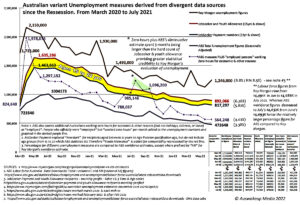
To a limited extent, the public is not unfamiliar with the ABS’s methodology’s shortcomings. One has only to look to any social media posting about unemployment and find someone who angrily points out that “people are ‘employed’ if they work one hour a week”. The problem with this “shortcoming” is that it is easy and unnuanced to understand for the statistically illiterate. It is not entirely accurate or as significant as people think. I have previously dealt with the “one hour a week” misrepresentation in my article “Unemployment numbers likely worse than projected”, so I don’t want to rehash that. Instead, there is also the significance of the impact compared with people who have a “job attachment”, to use ABS’s terminology, but – because of their uncertain status in the GIG economy – have zero work and pay (90,600 in July – see graph). It isn’t folks who get a few hours on a shift once a month but people who get nothing and are still registered as “employed” by the ABS because of their “job attachment”. During the pandemic, the numbers in this class were significant (higher than one million – see graph), but they have dropped to the level of people working the equivalent of a single shift for a month.
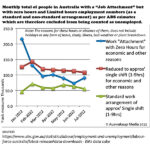
For example, in July 2022, there were only 54,900 people who worked between 1 and 9hrs in a month as a standard work arrangement. In addition, 66,200 worked similar hours because there was either “no work, not enough work, or stood down”. On top of that, in July, another 41,600 people had their working hours reduced to as few as 1-9hrs for “other” reasons that did not involve any form of leave (annual or otherwise), sickness, injury, maternity, plant breakdown or bad weather. These are all accordingly counted as “employed” by the ABS. Considering them as “employed” is technically accurate, although significantly underemployed. One certainly can’t be earning a living on less than nine hours of work a month.
Irrespective of where you put your cutoff point on working hours for registering someone as unemployed (and surprisingly zero, isn’t it), numerous other exclusions preclude people from being counted as unemployed. This fails the “so-called pub test”. I have listed these in my article “Frydenberg’s Maths problem”. The result is that, even if you added people who had a “job attachments” – but zero hours of work – the ABS estimate is smaller than, people receiving Job Seeker (let alone adding Youth Allowance – 15 to 22yrs – into the equation). There was a three-month period last year when that wasn’t true, which tells you that not all unemployed people register for JobSeeker. (Explained in “Josh’s Jobless Jargon”).
Real Domestic Unemployment
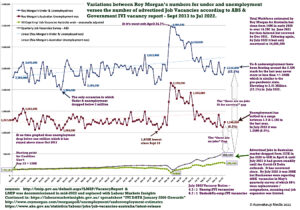
These statistical anomalies leave Roy Morgan’s estimate as the best likely accurate reflection of domestic unemployment in Australia at 8.5% (or 1.2 million people). But of course, the Job Summit is unlikely to admit real unemployment is more than twice what ABS’s international comparative measurement standard, claims. As such, the Job Summit only acknowledges a subset of the genuinely unemployed, as the problem area. In that case, it is no wonder they are grooming us to believe that Job vacancies are rising to the point where there are close enough to absorb most of the unemployed. One supposes you have already read these “excited” claims in the media. In that case, the unacknowledged aspect is that they’re admitting there have never been enough jobs previously to absorb the subset of the unemployed that ABS claims. This renders all the previous admonitions to the unemployed to “just get a job”, pretty hollow.
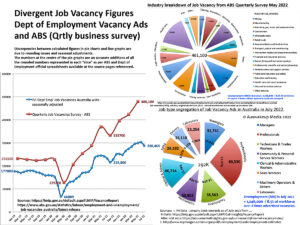
That raises two questions
1. What is the actual gap between job vacancies and the under and unemployed
2. How compatible are the job vacancies with the skills available in the community for the unemployed to be absorbed?
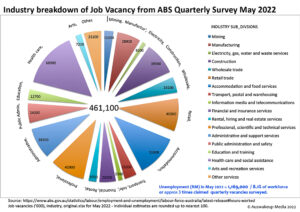
Now there are two measures of vacancies available. The Department of Employment’s internet vacancy index (IVI), and ABS’s quarterly survey of vacancies claimed by businesses. The IVI was more significant in previous decades than the ABS’s claim (see Roy Morgan graph). This discrepancy has changed in recent years, which I explained in “Vacant Claimants”. The fact is that even taking the largest count, the gap between job vacancies and Roy Morgan’s realistic unemployed figures is enormous. The opportunities for people with limited skills (lacking expensive university education) are just as limited now as when I wrote “The myth of Jobs Growth”. As you can see from the graph of divisions of jobs and industries where vacancies exist, most of them are still only available for the professional/educated market.
Farmer’s Plight
Instead, we still focus on the smallest unskilled end of employment opportunities, as depicted by the article this week, “Nobody wants to work: Fruit left to rot leaves, farmers feeling sour” page 8 of Tuesday’s (30th Aug) SMH. I long ago addressed this in “Low hanging Fruit”. Alternatively, the government could develop a comprehensive agricultural industry labour market policy. This policy should include government means-tested subsidisation of core wages at an adequate level, paying members of the agricultural workforce, with less profitable (but still essential) farmers providing monetary incentives to promote performance. This should include government coordination with Tafes and Universities and agricultural employers to provide a clear career path spanning entry-level agricultural roles to agriculture science and management qualifications at degree and post-grad levels. The package should include the government providing business coaching and mentoring to agricultural employers to build their capacity to be “employers of choice”. Adding offerings such as a cafeteria-style remuneration package of transport, accommodation, meals, training, on-the-job components of vocational credentialing and performance-based pay.
The contemporary issue, as usual, is poor pay and conditions, which the Job Summit needs to handle. The solution on offer is more migrants who will work for a pittance. This is in the face of over a million people unemployed in Australia and over another million underemployed. This statement is largely true of any month in the previous decade, with minor exceptions for underemployment before 2017 when it fell as low as 917,000.
Full Employment Summit?

Interestingly Albanese’s claim of the Job Summit was to seek a “Full Employment Summit”. But unfortunately, the neo-liberals adhere to the conservative myth of the NAIRU instead of a NABIER, which suggests we are already “fully employed”. A goal that has been achieved if you conclude ABS measures domestic unemployment. This is why “what gets measured” is essential. But, of course, if you want more realistic “full employment” policies, look at that instigated by the Curtin Government from 1945 to 1974. During which unemployment was dominantly measured at 2%. Then we would have the beginnings of a proven policy that survived decades until the introduction of neo-liberal policies under Whitlam, Hawke and Keating. For an informative reading on that, get a hold of Elizabeth Humphrey’s 2020 book, “How Labour Built Neoliberalism”.
The framework of a Federal Jobs Guarantee and what it could achieve for wages and workers has evolved from Curtin’s conception to a far more robust framework than that of the 1940s. Dr Steven Hail’s paper on a Job Guarantee is among the architects of alternatives. However, given that 30% of the attendees of the Job Summit are from the Business community and 30% from Unions, I very much expect such solutions will not even get a hearing in a barely two-day conference.
Given the minor target nature of political reforms exhibited by Labor to date where:
- they raise the minimum wage but not Jobseeker,
- send one family of refugees home but don’t address the rest,
- talk about addressing climate change but allow further gas mining,
- limit debt-related deductions for multinationals but refuses to concede an end to stage three tax cuts,
it is evident that state capture by industry donors is still a problem.
Hence we should expect far more modest recommendations from the Job Summit, which will involve more migrants, claims about needing even more productivity and further capitulation to vested business interests.
Real solutions
I don’t doubt that concessions will be generated from the Job Summit, but they will be bandages rather than solutions. But what would serious reform of the jobs market include?
1. Restoration and widening the scope of the public service/taxation/health/education/industrial relations departments.
2. Reviewing agricultural policy that subsidises agricultural employment – subject to annual review of employee conditions – to maintain viable, essential food security and attract Australians to farms. (As outlined above).
3. Nationalising private employment agencies and implementing ambitious public sector-driven active labour market programs comparable to what exists in Scandinavia.
4. An end to TAFE & university education fees to facilitate a more highly educated public that can reduce the growing professional job vacancies.
5. Establishment of technically based career paths from entry-level positions to professional and senior executive roles.
6. A return to centralised wage-fixing such as what existed in the 1970s.
7. A decrease in the exploitation of migrant labour by increasing random fair work inspections of workplaces backed by substantial legal penalties.
8. Expansion of cadetships and apprenticeships, and graduate programs in public service departments.
9. End costly Public Private Partnerships infrastructure projects to staff public sector expertise for infrastructure development fully.
10. A Federal Job Guarantee linked to career paths.
11. Implementing a Green New Deal where energy and transport infrastructure is wholly returned to the public sector.
I am confident I can predict none of these, especially the re-conceptions of the public sector, will come out of this week’s end Jobs Summit. The reason is necessary, and fair reform isn’t on the agenda. Besides this, the way they measure Australia’s unemployment and the issues and focus on what job vacancies matter is misdirected.